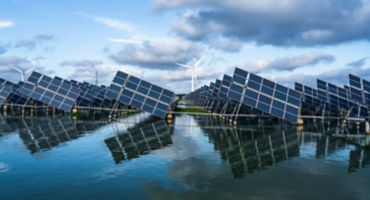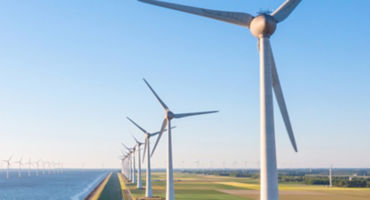- Global Industry Analyst
Skip to main content
- Funds
- Insights
- Capabilities
- About Us
- My Account
The views expressed are those of the authors at the time of writing. Other teams may hold different views and make different investment decisions. The value of your investment may become worth more or less than at the time of original investment. While any third-party data used is considered reliable, its accuracy is not guaranteed. For professional, institutional, or accredited investors only.
The transition to a lower-carbon economy will likely require staggering amounts of electricity. As the world advances toward its decarbonization goals, demand for electric vehicles and appliances, heat pumps, and a wide range of electrified industrial, transportation, and agricultural processes should increase dramatically. At the same time, the exploding appetite for data from expanding connectivity, automation, and the dizzying pace of machine learning and artificial intelligence, will also likely intensify the draw on electrical grids. The International Energy Agency (IEA) estimates that electricity demand in North America and Europe alone will grow by more than 2% per year through 2050, a nearly tenfold expansion over the 2010 – 2021 period (Figure 1). Electricity demand will likely rise even faster in emerging markets.1
Figure 1
Renewable power sources, including solar and wind, supply power intermittently. Without large-scale storage capacity, solar panels can only provide power when the sun is shining, and wind farms only when turbines spin. Despite their intermittency, the cost to develop renewables continues to decline, and sweeping policy and legislation have supported their adoption. As a result, wind and solar supply a greater share of power to electric grids. At the same time, baseload coal, natural gas, and nuclear plants — which can generate power 24 hours a day, seven days a week — are gradually being retired. As Figure 2 shows, in North America and Europe, solar and wind are projected to account for 66% of electricity supply by 2050, up from just 14% in 2021. Conversely, the contribution from baseload power is projected to shrink to 17%, down from 68% in 2021 — a symmetrical reversal.
Figure 2
In our view, the combination of structurally higher electricity demand and transitional power-supply instability will result in greater power-price volatility than consumers currently experience. To mitigate jarring intraday and seasonal power-price swings and ensure a constant supply of electricity, grids may rely on two mainstays: large-scale batteries and flexible-power generation.
Intraday price fluctuations may boost demand for batteries
Batteries can help mitigate intraday power-supply instability, particularly for grids with heavy reliance on renewables. Solar power best illustrates the reasons why. Solar panels generate all their electricity during daytime hours; they generate little to no power after the sun has set. In places with high solar concentration on the grid, power prices tend to be lower during the day and higher during nighttime hours. The inverse relationship between renewables’ supply capabilities and power prices means that solar essentially reduces its own value by generating electricity when power prices are low, and going dormant when prices are high.
Figure 3 shows a day in the electrical life of California, the state with the highest share of solar power in the continental US, with 19% of its electricity generated from solar installations. The red shaded area shows the hours when power prices were lowest, while the green area shows the hours when prices were highest. During the lowest-cost hours, renewables supplied more than half of California's electricity needs. At night, when prices were highest, renewables supplied far less (with solar dropping to zero). Natural gas, on the other hand, supplied most of California’s electricity during the evening hours, when prices were highest. Because natural gas generators can ramp up production during peak-demand hours when renewables are unable to supply power, they function as critical stabilizers for electric grids like those of California.
Figure 3
This brings us to the importance of batteries. Batteries help smooth intraday supply and pricing volatility by charging during daytime hours, when solar is abundant and electricity prices are lowest, and discharging power at night, when solar is absent and prices are highest. Because batteries can improve the supply/demand balance during low-priced hours, solar products and batteries are increasingly deployed as a package.
Seasonal pricing volatility may be a tailwind for flexible-power generation
Expanding reliance on renewables will also likely result in higher seasonal power-price volatility. Figure 4 shows Europe’s trailing seven-day electricity demand and trailing seven-day solar supply in 2022. During the winter months, solar panel production drops dramatically given lower solar irradiance (weaker sunlight and fewer hours of it). Conversely, during the summer months when solar irradiance is higher (stronger sun for more hours), solar panels generate lots of power. Data shows that the price of power in Europe is typically lowest during the second and third quarters — the spring and summer months when solar is most productive. Prices are highest during the first and fourth quarters, which coincide with autumn and winter, the least productive periods for solar.2
Figure 4
A solution to seasonal instability and pricing volatility is flexible-power generation. Power plants that can flex, shifting from intermittent renewables to natural gas and other baseload power sources during the winter months should be able to ensure grid stability and benefit from these periods of higher power prices. While batteries are unable to solve seasonal power-price mismatches (it is not feasible to charge a battery once during the summer and wait several months to discharge it in the winter), flexible-power generation is highly effective.
While this paper explores the potential rising value of storage and flexibility to solve the intermittency of renewables, we remain positive on the future of renewable power development. Meeting the enormous challenge of the energy transition will require traditional fossil fuels, bridge fuels like natural gas, and renewables. Coupled with investments in technology, transmission, and dispatchable power, demand for renewables should continue to grow, in both developed and developing countries. National decarbonization commitments and concerns around energy independence and security should also support their continued adoption. The current negative correlation between renewable-power generation and electricity prices simply means that renewables will likely have the most investment value when they are regulated, long-term contracted, or part of a diverse portfolio that includes exposure to battery and flexible-power generation assets.
As the low-carbon transition progresses, the world will consume far more electricity than it does today. At the same time, as the supply mix includes a greater share of intermittent renewables, particularly in Europe and North America, grids may become less stable and prices more volatile. The resulting instability may increase the value of large-scale batteries and flexible-power generation, which will be necessary to stabilize the power system on daily and seasonal bases. By diversifying their power-supply mix and incorporating these capabilities, grids may be better equipped to provide uninterrupted power to consumers at more stable prices.
Similarly, we believe that investors will see the most value by diversifying among investments in renewables, batteries, and flexible-power generation assets. To date, the market has treated last year’s flexible-power-generation profits as a one-time event — a simple windfall profit. It is our view that power-price variability will be a recurring, disruptive factor for energy grids across developed markets. The profits reaped by flexible-power companies may therefore be repeatable. Specifically, we expect companies with focused exposure to flexible gas-power generation, battery and storage technology, and renewables may continue to surprise to the upside, as the market appears to underappreciate the value of this asset mix. Other beneficiaries could include integrated utilities that own a portfolio of renewables, batteries, and flexible-power assets, albeit in smaller proportion to their total business mix. Similarly, regulated electric networks may see tailwinds from investments in grid hardening and the capacity to balance growing demand with the intermittency of renewables.
Please also see our white paper from 2021: Power move: Why electric utilities may be the key to the energy transition.
1 In our view, developed markets represent the bulk of the current investment opportunity in this space, as alternative energy capacity as a percentage of total power production is higher than it is across the developing world. | 2Wind speeds and consistency lack the seasonally predictable patterns of solar irradiance. The contribution to the grid also varies widely by geography, so we have excluded it here.
To read more, please click the download link below.
Stay up to date with the latest market insights and our point of view.

Navigating AI resource demands: Strategies for sustainable data center operations
AI's growing computational demands are raising critical questions about energy efficiency and water-resource management. We delve into strategies for enhancing sustainable data center operations, highlighting the importance of proactive resource stewardship.

What’s next after Iran’s missile attack on Israel?
Geopolitical Strategist Thomas Mucha shares his analysis of the latest escalation in the Middle East conflict, including his thoughts on a wider regional war and the market implications.

Commodities: Entering a scarcity-pricing regime
Is copper the oil of the energy transition? Here, we provide a view of this important commodity’s future, captured in four charts.

Thematic investing focus: evolving the current generation of energy
The energy transition is taking place amid a greater focus on energy security and affordability. What could this mean for the role of traditional energy companies, ask Keith White Daouii Abouchere and Megan Galligan.

Thematic investing focus: advancing the next generation of energy
The decarbonisation process represents the biggest capital cycle in our lifetime. As we develop the next generation of energy, Keith White, Daouii Abouchere and Megan Galligan examine how thematic investors can make the most of this structural opportunity.

Look past the cycle: The surprising total return potential of natural resources and commodities
Portfolio manager Nick Petrucelli explains the cyclical, structural, and macro tailwinds behind this opportunity.

Navigating the opportunities and challenges of the energy transition
Two of our climate- and energy-focused investment professionals discuss what the low-carbon transition may look like and how investors can think about the challenges and opportunities it represents.
Russia/Ukraine: One year in with no end in sight
Geopolitical Strategist Thomas Mucha analyzes the impacts of the Russia/Ukraine conflict one year in and identifies potential longer-term effects.

How to invest amidst a still unfolding energy crisis?
In this ActiveViews webcast, senior climate – and energy – focused professionals explore the still unfolding energy crisis in Europe and the associated challenges and opportunities for investors.

Building climate resilience: Toward a practical corporate framework
The need for systemic climate change resilience is becoming clear. We present a practical framework to help companies enhance resilience in their own operations.

Wind at their backs: What the IRA means for clean energy industries
Members of our energy and utilities teams break down the range of impacts of the US Inflation Reduction Act on companies in their sectors.
URL References
Related Insights